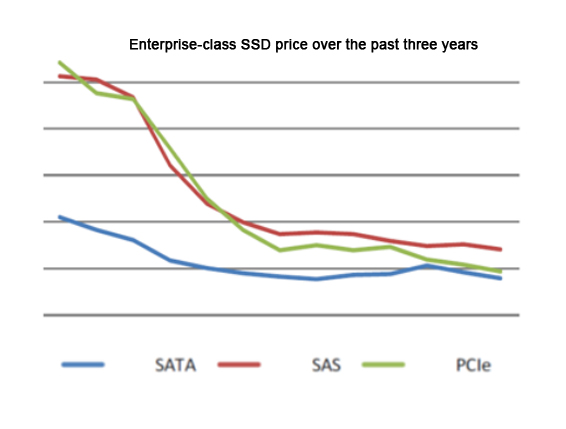
As the falling price of client SSD from 2018 to 2019, the average price is nearly close to $0.15 per GB. The price of some SSD with capacity of 500GB is even less than $60. Reducing price also promotes the needs for SSD.
The shipment of global SSD is above 205 million which increases 31% compared with 2017, while the shipment of client SSD is nearly to 176 million. The falling price stimulates the increase of market demand, so the share of HDD will be further reduced, and the development of client HDD technology will be faced with stagnation and accelerated demise.
The popularization of 96-layer NAND and QLC NAND technologies are going to be the main factor of the falling price of SSD, which will have the impact on the solid state disk choice of desktop and laptop computers.
Even the HDD manufacturers try to reduce invest and cut cost to maintain its business, the impact from new technological innovation will continue to damage HDD. The price of SSD will consecutively and fast reduces in 2019. There are three trends in future.
Technology generalization
While 64-layer TLC SSD is steadily shipped, the popularization of 96-tier and QLC technology and capacity release are gradually extending. As shown in the following figure, the higher stacking layer, the larger capacity of flash particles on a unit silicon substrate, and the lower the cost of NAND flash unit capacity. It is just like the real state that the price of each room varies greatly not only bungalows but 96–storey buildings in the same piece of land.
The NAND technology has developed rapidly from 2014. For example, the original technology that a piece of land can only be built a bungalow has been upgraded to the advanced technology of 96-tier building. It is not difficult to understand that the SSD price falls so quickly.
The development of 3D technology
The 96–player stacking technology is making progress, Samsung, Toshiba and Western Data grow rapidly, while Intel and Micron are behind them. China-made Yangtze River Storage has skipped 96 layers to 128 directly.
Samsung has already launched 970 EVO Plus SSD based on 96-tier stacking technology. The BG4 SSD of Toshiba, Kingston A2000 SSD and 3D NAND SSD based on 96–tier from other manufacturers will be launched later in 2019 in order to seize up the opportunity of market booming.
In addition, NAND flash memory manufacturer has already attempted QLC technology to increase storage density from another dimension. Four bits per room further reduces costs from three to four, compared with 3 bits TLC.
Which not only reduces costs, but also improves output. The era is coming where the size of 2~4TB NAND chip is similar to a nail cap.
At present, it has been approved by business practices that the future road of QLC is feasible.
Obsolescence of client HDD from 240GB.
As the average SSD capacity will increase in 2019, where the capacity of laptop and PC have already been above 240GB, 250GB or 256GB and the standard of next mainstream consumption is close to 480GB. The laptop price is going to continue falling, especially as more QLC and 96–tier SSD enter market. Some high-end notebook models with 1TB SSD have also entered the market, but which is still too small for enterprise applications.
At the same time, the market of laptop and smart phone is mature and the demand growth is limited, which leads to an excess of NAND flash memory supply and smaller price gap between 480GB SSD and HDD. SSD cost performance will further improve, so users will choose faster SSD to discard HDD.
HDD of SATA interface is far inferior to M.2 SSD of NVMe interface in performance. NVMe M.2 SSD has become the first choice of laptop products.
There are two aspects in accelerating the market of NVMe SSD. First, the SSD control chip support of Marvell, Silicon Motion, Phison such manufacturer is mature. The cost of these controllers has also been rapidly optimized and reduced, far less than the complexity of HDD controllers, and multi-manufacturer competition has supported consumers to obtain a cheap price experience.
Meanwhile, some major SSD brands, such as Samsung, Toshiba and WD-Sandisk, have also launched their products of NVMe SSD autonomous and OEM controller.
Generally speaking, the shipment of client HDD will continue to reduce, because 500G SSD price has already been close to 1TB HDD in sales channel.
The application of 96–tier QLC NAND technology leads to SSD further price reduction. Therefore, client HDD may disappear from the world. It was analyzed that the market of other enterprise HDD is small reducing the difficulty of its technology development and investment. At least the cost is more difficult to reduce, so the future development of enterprise HDD is also very worrying!